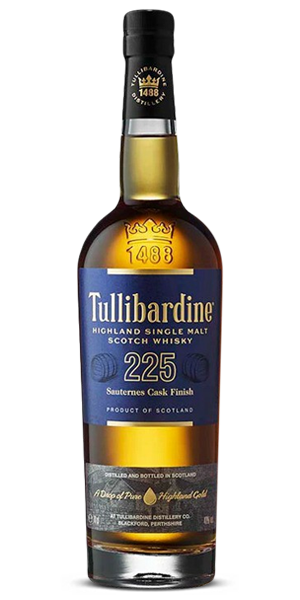

Tullibardine 225 Sauternes Finish Scotch (700mL)
 Only left •Last few at this price. Grab it now!
Only left •Last few at this price. Grab it now!
- BrandTullibardine
- CategorySingle Malt Scotch
- CountryScotland
- RegionHighland
- DistilleryTullibardine
- AgeNAS
- Style Single Malt Scotch Whisky
- Maturation Sauternes Wine casks
- Alcohol 43%
Girl-next-door perfect Whisky.
If we set out to find the oldest brewing and distilling spot in Scotland, Tullibardine would definitely be in the running. Back in the 15th century, King James IV — a young, strapping lad — made a stop at the local brewery here on the way to his coronation. Heck, wouldn't you? This is recorded as the first "official" purchase of beer in kingdom (though we think it's fair to say that there were quite a few "unofficial" purchases being made at the time). The name Tullibardine means "vantage point" in Gaelic and originates from a little medieval chapel, set up in 1446 near the distillery.
The old brewery was transformed into a distillery back in about 1946 and has become a solid maker of Single Malt Whisky. They produce their signature Whisky, several finished "double-wood" Whiskies, and some older limited editions.
We’ve mentioned Tullibardine’s interesting naming system for their finished wood Scotch Whiskies before. They call their standard Single-Malt Sovereign and is a marriage of young and older Whiskies. The finished wood products are aged one more year in various barrels types and named for the size of the finishing barrel. Tullibardine 225 Sauternes Finish is so-called because the Sauternes Wine casks are traditionally 225 liters in size. It’s kind of like numbering a car model after its engine size.
Sauternes Wines are sweeter and more dense than their Bordeaux cousins. The net effect is like aging your Whisky in a cross between a Tawny Port cask and a young Sherry cask. The full-bodied Spirit that emerges is bright, light, and refreshing with a pretty pale gold hue and a rich citrus and pineapple flair that is just girl-next-door perfect.
This dram was awarded 95 points in the Ultimate Spirits Challenge and a Silver Medal from the International Wine and Spirits Competition… just say’in.
Smartass Corner:
Sauternes Wine — like most great discoveries — happened by accident. There is a mysterious fungus — Botrytis cinerea, noble rot — that every once in a while infects a bit of the Sauvignon blanc grape harvest. It makes the grapes grow shriveled and small. The snobby winemakers used to throw the infected grapes away. But some enterprising folks discovered that it actually made a densely sweeter wine. Now these special grapes can be very expensive.
This product is available in:
Note: Once an order has been safely & successfully delivered, we do not accept returns due to change of heart or taste. Due to state regulations, we cannot accept the return of alcohol purchased by a customer in error.















